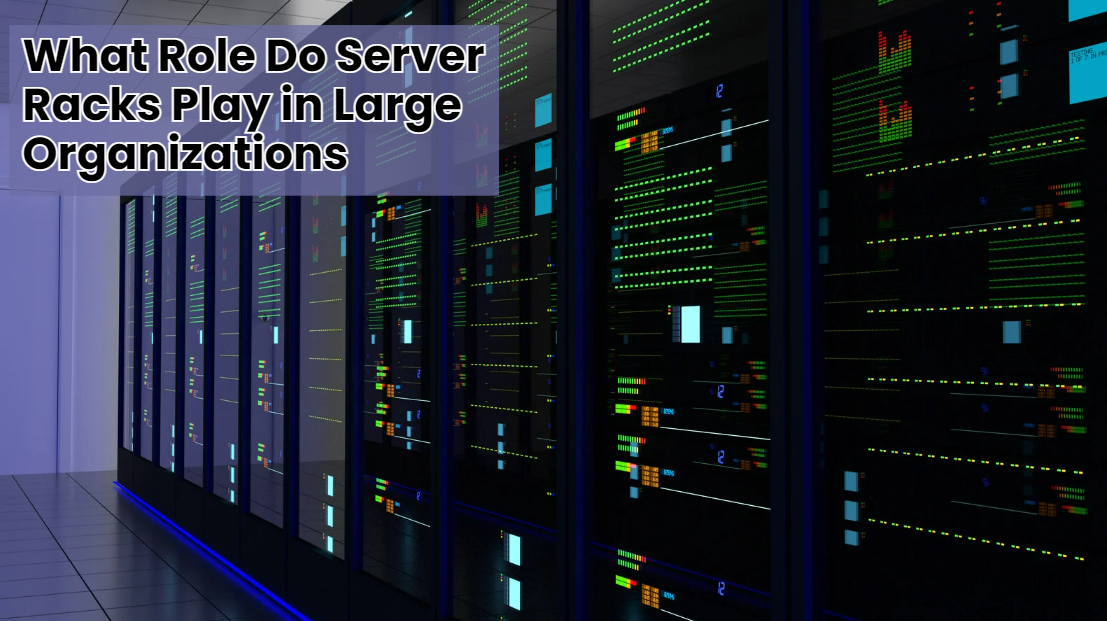Have you ever wondered how large organizations maintain extensive IT infrastructure, such as data processing, secure communication, and everything in between, without a hiccup?”
How they arrange, safeguard, and keep running the thousands of servers and networking equipment that form the backbone of their daily activities is the oftentimes overlooked yet significant role of server racks.
These unsung heroes stay behind the scenes to support the backbone of any company’s technology ecosystem. Let’s delve into the key functions of server racks in large organizations and why they are so necessary.
Organization and Space Management
Server rack design optimizes the available space within data centers. In large organizations, where space often comes at a premium, server racks enable vertical stacking of servers and other equipment.
This not only saves precious floor space but also makes it easier to access each component. By systematically arranging the equipment, server racks help maintain a clutter-free environment that is so essential for efficient maintenance and troubleshooting.
Improved Air Flow and Cooling
Airflow and cooling are principal factors for the performance and life of servers and all associated hardware. Server racks are designed to facilitate optimum air flow, thus ensuring that hot air is expelled and cool air is circulated effectively. A good number of server racks have perforated doors and panels that facilitate improved ventilation.
Coupling server racks with cooling solutions, such as fans, air conditioning systems, and liquid cooling, helps to maintain the best temperatures. In large organizations, where hardware is run at high density, hence generating a lot of heat, effective cooling through server racks is critical.
Enhanced Security
The top priority for large organizations in protecting vital data and other critical infrastructure is security The server racks of the 4u server case include a few levels of physical protection, of which the lockable doors and side panels are a part. They give a defense against unauthorized access and tampering with the equipment.
Protection measures such as video cameras, access control systems, and environmental monitoring sensors can be installed on many server racks. Such security may prevent the breach of an area where the organization can assure the integrity of its IT infrastructure by keeping the equipment in secure server racks.
Scalability and Flexibility
To a large extent, every big organization is growing and its requirements for IT keep changing. Server racks are designed to scale and be flexible to the constantly changing environment. In modular server racks, it becomes easy to add or remove equipment without much hassle, and an upgrade or expansion is pretty smooth.
This flexibility is more valued when an organization is required to undergo digital transformation or implement new technologies. Customized server racks can meet special requirements so that the IT infrastructure scales with the organization’s requirements.
Cable Management
A well-managed data center is only as good as its cable management. Integral cable management in server racks comes in the form of cable trays, hooks, and management panels, which help route and secure all kinds of cables to avoid cable entanglement and damage.
Neat cabling also allows for easier maintenance and reduces the downtime needed for troubleshooting and repairs. In larger organizations, the amount of cabling can be huge, and server racks in such a case play their part in keeping the cabling system tidy and organized.
Fully Optimized Power Distribution
One more critical aspect of data center management is power distribution. The server racks also include PDUs, enabling the distribution of electrical power for several servers and other equipment in the rack. They are available in many configurations, offering a host of features such as load balancing, remote monitoring, and energy efficiency.
By integrating PDUs into server racks, businesses will be able to provide a stable and reliable power supply, reduce energy consumption, and monitor power consumption effectively. This is more so in large organizations seeking to efficiently manage their consumption of energy to reduce operation costs.
Easy Maintenance and Troubleshooting
Server racks are made to allow easy maintenance and troubleshooting. Equipment in the racks is so organized that each component can be easily located and reached. Slide-out rails and tool-less mounting options are featured on many server racks to ease the installation and replacement of hardware.
This accessibility is very crucial to the reduction of time wasted on maintenance and decreasing the possibilities of downtime of a running critical system. In big organizational setups, where IT downtime may mean loss of business, this becomes very beneficial to have a maintenance-friendly server rack design.
Industry Standard Compliance
For large organizations, stringent regulative requirements and industry standards are usually in place regarding data security, privacy, and operational efficiency. These racks meet such standards, bringing along features to support their compliance.
An example is the installation of environmental monitoring sensors in the server racks to ensure that the data center environment meets regulatory specifications, from temperatures to humidity and other conditions. Compliance with the industry standards not only safeguards the organization from legal and financial penalties but also adds to its reputation and reliability.
High-Density Computing Support
With the technological evolution through virtualization and cloud computing, this demand has risen for efficient and scaled solutions for mounting equipment in racks. High-density server racks are designed to support more servers and other equipment within a very small footprint, hence maximizing the use of available space.
These racks support the higher power and cooling requirements linked with high-density environments, ensuring optimal performance and reliability. Server racks provide the necessary infrastructure for large organizations to leverage high-density computing.
The Role of Server Racks in Power Distribution
| Aspect | Description | Benefits |
| Power Distribution Units | Server racks integrate PDUs to distribute electrical power to servers and equipment. | Ensures a stable and reliable power supply. |
| Load Balancing | PDUs offer load balancing features to manage power distribution evenly across devices. | Prevents overloading and improves energy efficiency. |
| Remote Monitoring | Advanced PDUs allow for remote monitoring and management of power usage. | Enables proactive maintenance and reduces downtime. |
| Energy Efficiency | PDUs can be designed to optimize energy consumption. | Lowers operational costs and supports sustainability initiatives. |
| Redundancy and Failover | Redundant power supplies and PDUs ensure continuous operation during power failures. | Enhances reliability and minimizes the risk of system downtime. |
Conclusion
In all, server racks are the very backbone of the IT infrastructure in any large organization. They provide a great deal of functionality in terms of efficient use of space, increased airflow and cooling, enhanced security, scalability, and effective cable management.
They also provide optimized power distribution, ease of maintenance, compliance with regulations, and high-density computing. In their capability to provide structured and secure environments for housing critical hardware, server racks can enable large organizations to reach business objectives by helping to maintain a competitive edge in the digital age.
FAQs
- What is a server rack?
A server rack is a metal framework designed to house servers, networking equipment, and other hardware components in an organized manner.
- Why are server racks important in large organizations?
Server racks optimize space, improve airflow and cooling, enhance security, and facilitate efficient cable management, all essential for maintaining a robust IT infrastructure.
- How do server racks help with cooling?
Server racks are designed to promote efficient airflow, often equipped with perforated doors and panels, and can integrate cooling solutions like fans and air conditioning units.



